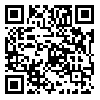Volume 11, Issue 4 (17 2013)
jhosp 2013, 11(4): 25-34 |
Back to browse issues page
Download citation:
BibTeX | RIS | EndNote | Medlars | ProCite | Reference Manager | RefWorks
Send citation to:



BibTeX | RIS | EndNote | Medlars | ProCite | Reference Manager | RefWorks
Send citation to:
Vali L, Pourreza A, Ahmadi B, Akbari Sari A. Quality assessment tools and Management for medication prescription in elderly. jhosp 2013; 11 (4) :25-34
URL: http://jhosp.tums.ac.ir/article-1-11-en.html
URL: http://jhosp.tums.ac.ir/article-1-11-en.html
Abstract: (11355 Views)
Background: aging is a very sensitive period of life and paying attention to the problems and requirements of this period seems to be a social necessity. Improving medication for old patients is challenging and sometimes medication`s benefits are less than its disadvantages for the patient.Because of the numerous evidences of problems caused by medication in the elderly in the recent decade, many specialists and physicians have introduced tools and techniques for identifying these problems which are caused by medication and prescription of risky medicines.
Materials and Methods: Several methods, tools and criteria for assessment of quality of medication and medicine prescription in elderly have emerged since 1990.. We found out two categories of criteria reviewing the literature which are generally named as distinct criteria (criterion based) and implicit criteria (judgement based).
Result:The distinct category including Beers, Zhan, McLeod, Laroch and STOP/START criteria are all developed by a panel of experts and consensus in several stages. The second category of criteria concentrates on evaluation of clinical information.
Conclusion: All the tools and methods described in this study are used in Europe and in the USA which have limited market similarities with our country thereforedevelopment of tools for assessing prescription quality for the elderly in Iran is absolutely necessary.
Materials and Methods: Several methods, tools and criteria for assessment of quality of medication and medicine prescription in elderly have emerged since 1990.. We found out two categories of criteria reviewing the literature which are generally named as distinct criteria (criterion based) and implicit criteria (judgement based).
Result:The distinct category including Beers, Zhan, McLeod, Laroch and STOP/START criteria are all developed by a panel of experts and consensus in several stages. The second category of criteria concentrates on evaluation of clinical information.
Conclusion: All the tools and methods described in this study are used in Europe and in the USA which have limited market similarities with our country thereforedevelopment of tools for assessing prescription quality for the elderly in Iran is absolutely necessary.
Received: 2012/06/5 | Accepted: 2012/09/3 | Published: 2013/10/7
| Rights and permissions | |
 |
This work is licensed under a Creative Commons Attribution-NonCommercial 4.0 International License. |





